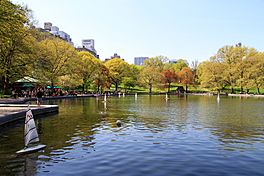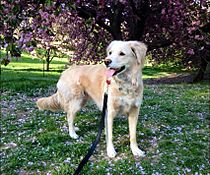Conservatory Water facts for kids
Quick facts for kids Conservatory Water |
|
|---|---|

Conservatory Water, facing south
|
|
| Location | Central Park, Manhattan, New York City, New York, USA |
| Coordinates | 40°46′27″N 73°58′03″W / 40.77418°N 73.96747°W |
| Type | pond |
Conservatory Water is a beautiful pond in Central Park, Manhattan, New York City. It sits in a natural dip in the park, near Fifth Avenue and East 74th Street. The pond is surrounded by pretty, shaped hills like Pilgrim Hill and Pug Hill. These hills are covered with trees, including lovely Yoshino cherry trees.
The pond gets its name from a glass-house that was planned for tropical plants nearby. You can find the Kerbs Memorial Boathouse on the pond's edge. Here, you can rent and sail radio-controlled model boats. There are also cool bronze sculptures around the water.
Water for the pond used to come from the Ramble and Lake, which was once a stream called Sawkill. When Central Park was built, water lilies grew naturally in the pond. Later, this natural lily pond was changed into the model boat pond you see today.
Contents
History of Conservatory Water
Conservatory Water was named after a large glass-house that was meant to grow tropical plants. This glass-house was planned to have a grand staircase leading up to it from Fifth Avenue. The idea for this garden was part of the original Greensward Plan from 1857. This plan won a design competition for Central Park.
The park's main designers, Frederick Law Olmsted and Calvert Vaux, suggested building a conservatory with a "hard-edged" reflecting pool. However, only the reflecting pool was built.
At first, a natural-looking pond for water lilies was dug out. The steep bank towards Fifth Avenue was planted with many shrubs and trees. Samuel Parsons, who helped design the park, described the pond in 1891. He said it was oval-shaped with uneven shores. Rocks were placed to make it look natural, not man-made. The pond was shallow, only about three feet deep, and had a cemented bottom.
The water came from the Sawkill stream, which flowed through the area. Hardy water lilies grew in the mud, and delicate ones were kept warm in the park's conservatory during winter. This conservatory is now the site of Conservatory Garden.
Since the 1860s, children have enjoyed sailing their model boats here. Over time, the natural water lily pond was changed into a special pond for model boats. It was inspired by a similar pond in the Jardin du Luxembourg in Paris.
The pond's edge is made of "Atlantic Blue" granite, which was added in 2000. It is now home to many model sailboats.
The model sailboats became famous from E.B. White's children's book Stuart Little (1945). The story is about a mouse-like boy who sails his ship on Conservatory Water. This book was also made into a popular family movie in 1999.
Kerbs Memorial Boathouse
On the eastern side of Conservatory Water is the Kerbs Memorial Boathouse. It was designed by architect Aymar Embury II. This is where visitors can rent radio-controlled and wind-powered model boats.
The boathouse was built in 1954. It has a picnic-style Georgian design with red brick and a green copper roof. Outside, there is a flagstone patio. The boathouse stores model sailboats and is home to the Central Park Model Yacht Club.
Surroundings of the Pond
The waters of Conservatory Water are home to tiny, unusual freshwater jellyfish called Craspedacusta sowerbyi during certain seasons. High above the pond, a red-tailed hawk named "Pale Male" once made a nest. This hawk was watched by many bird-watchers in the park.
Pilgrim Hill: A Fun Spot

Pilgrim Hill is southwest of Conservatory Water. It is a popular place for many activities. In winter, when there's enough snow, people love to go sledding here. In spring, the hill is beautiful with pale Yoshino cherry trees blooming. During warmer months, it's a great spot for picnics and relaxing.
The hill has different kinds of trees, including cherry trees and nine types of oak trees. At the top of Pilgrim Hill, there is a bronze statue called The Pilgrim. It was made by artist John Quincy Adams Ward. The statue is 9 feet (2.7 meters) tall. It shows one of the Pilgrims, who were British immigrants. They sailed from Plymouth, England on the ship Mayflower in 1620.
The statue faces west from a small hill. It stands on a granite base made by architect Richard Morris Hunt. This base has four carvings showing the Mayflower ship, a Bible and Sword, a Cross-Bow and Arrows, and Commerce. The statue was given to New York City in 1885.
Pug Hill: A Dog's Delight
Pug Hill is located northwest of the Alice in Wonderland statue. In the late 1990s and early 2000s, it was a very popular meeting spot for pug dog owners. So many pugs would gather there that it looked like a "fawn and black whirlpool" of dogs. However, these gatherings eventually stopped because of park rules. In 2006, Pug Hill even inspired a book with the same name.
Alice in Wonderland Sculpture
Near Conservatory Water, there are several bronze sculptures. To the north, you'll find a sculpture that celebrates Lewis Carroll's Alice in Wonderland. This sculpture is 11 feet (3.4 meters) tall. It shows Alice sitting on a large mushroom at a tea party. She is with the Mad Hatter, the March Hare, the White Rabbit, the Dormouse, the Cheshire Cat, the Caterpillar, and her kitten Dinah.
The sculptor, José de Creeft, created it in 1959. Alice's face is modeled after the sculptor's own daughter. The sculpture was given by George Delacorte to honor his wife. Children love to climb on this statue, which was part of its design. At the bottom, you can find a line from Lewis Carroll's poem "Jabberwocky".
Hans Christian Andersen Sculpture
To the west of Conservatory Water, there is another sculpture. It honors the Danish writer Hans Christian Andersen and his story "The Ugly Duckling". This sculpture was made in 1955 by Georg John Lober. It shows a larger-than-life-size Andersen, about 9 feet 6 inches (2.9 meters) tall. He sits on a polished pink granite bench with an open book on his lap, showing the story of "The Ugly Duckling." A 2-foot (0.6 meter) tall bronze duck is at his feet.
On Andersen's left hand, the sculptor wrote a special message to his wife. This statue is also meant for children to climb on. Both the Alice in Wonderland and Hans Christian Andersen sculptures were built in the 1950s by NYC Parks commissioner Robert Moses. They were part of the park's "Children's District."
Waldo Hutchins Bench: A Whispering Spot
Overlooking Conservatory Water, near the park's East 72nd Street entrance, is a special curved white granite bench. It honors Waldo Hutchins (1822–1891). He was an important person who helped manage Central Park for many years. He also served in the U.S. Congress.
The bench is almost 4 feet (1.2 meters) tall and 27 feet (8.2 meters) long. It weighs several tons. The bench was designed by architect Eric Gugler and built in 1932 by the Piccirilli Brothers studio. This is the same company that carved the famous Lincoln Memorial in Washington, D.C.
The bench has a small sundial on its back, designed by sculptor Albert Stewart. The sundial has a bronze sculpture of a female dancer in its center. This sculpture was made by Paul Manship, who also created the large Prometheus statue at Rockefeller Center.
Lines are carved into the bench that show where the shadow falls at 10:00 a.m., noon, and 2:00 p.m. during the spring and fall. A cool trick about this bench is that if two people sit at opposite ends and whisper, they can hear each other easily! There are also two Latin sayings carved into the bench. One means "One must live for another, if he wishes to live for himself." The sundial says "Let it not be destroyed by the passage of time."
Images for kids
-
Alice in Wonderland by Jose de Creeft, 1959
See also
 In Spanish: Conservatory Water para niños
In Spanish: Conservatory Water para niños








